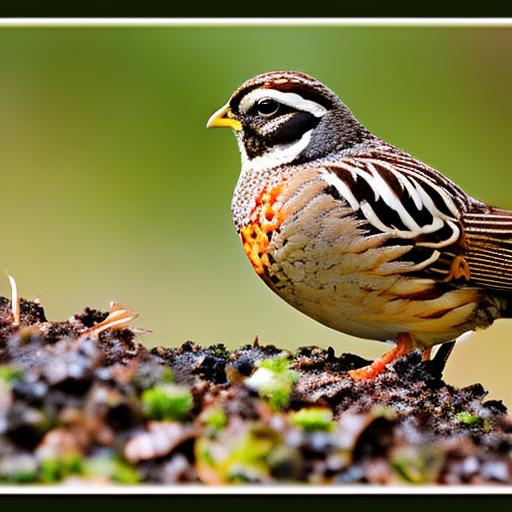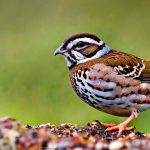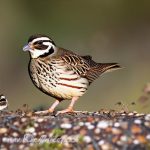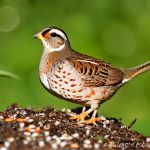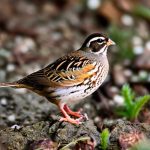Quails are small, ground-dwelling birds that are known for their social behavior and tendency to forage in groups. They are primarily active during the day and are often found in open grasslands, agricultural fields, and brushy areas. Quails are omnivorous birds, feeding on a variety of seeds, insects, and small invertebrates. They are also known to be attracted to gardens and yards that provide suitable cover and food sources. Understanding quail behavior is essential in effectively managing their presence in your garden. By knowing their habits and preferences, you can implement strategies to deter them from causing damage to your plants and landscaping.
Quails are known to be ground-nesters, preferring to build their nests in hidden, grassy areas. They are also attracted to areas with dense vegetation where they can find cover from predators. Additionally, quails are drawn to gardens with an abundance of seeds, grains, and insects. By understanding these behaviors, you can take proactive measures to make your garden less appealing to quails. This may include reducing dense vegetation, removing potential nesting sites, and minimizing food sources. By creating an environment that is less hospitable to quails, you can effectively discourage them from frequenting your garden and causing damage to your plants.
Key Takeaways
- Quails are ground-dwelling birds that are attracted to gardens with dense vegetation and open spaces.
- Physical barriers such as fences and netting can effectively prevent quails from entering and damaging gardens.
- Repellents such as predator urine or spicy sprays can deter quails from entering gardens.
- Scare tactics like motion-activated sprinklers or decoy predators can startle and discourage quails from entering gardens.
- Providing alternative food sources like bird feeders can divert quails away from gardens and reduce damage.
Creating Physical Barriers
One effective way to deter quails from entering your garden is by creating physical barriers that prevent their access. This can be achieved by installing fencing or netting around the perimeter of your garden or specific plant beds. Fencing should be at least 2 feet high and buried several inches into the ground to prevent quails from burrowing underneath. Additionally, the fencing should have small openings to prevent quails from squeezing through. Netting can also be used to cover individual plants or entire garden beds to protect them from quail damage. When using netting, it’s important to ensure that it is securely fastened and does not provide any gaps for quails to enter. By creating physical barriers, you can effectively limit the access of quails to your garden and protect your plants from their foraging behavior.
In addition to fencing and netting, the use of raised garden beds can also serve as a physical barrier to deter quails. Raised beds elevate plants off the ground, making it more difficult for quails to access them. This can be particularly effective for protecting vulnerable seedlings and young plants from quail damage. Raised beds can be constructed using a variety of materials such as wood, stone, or metal, and can be customized to fit the specific needs of your garden. By implementing physical barriers such as fencing, netting, and raised beds, you can effectively protect your garden from quail damage and minimize the need for more aggressive deterrent methods.
Using Repellents
Another method for deterring quails from your garden is the use of repellents. There are several types of repellents available that can be effective in discouraging quails from foraging in your garden. Chemical repellents often contain natural or synthetic compounds that emit odors or tastes that are unpleasant to quails. These repellents can be applied directly to plants or surrounding areas to create a deterrent barrier. Additionally, visual repellents such as scare tape or reflective objects can also be effective in deterring quails by creating a sense of unease or confusion. By using repellents, you can create an environment that is less appealing to quails and reduce the likelihood of damage to your plants.
Natural repellents such as garlic, chili pepper, or vinegar can also be effective in deterring quails from your garden. These substances can be mixed with water and sprayed onto plants or surrounding areas to create a deterrent barrier. Additionally, the use of predator urine or feces can also be effective in deterring quails by creating a sense of danger in the area. By using natural repellents, you can effectively discourage quails from foraging in your garden without the use of harsh chemicals. It’s important to reapply repellents regularly, especially after rainfall or irrigation, to ensure their continued effectiveness. By using a combination of chemical and natural repellents, you can create an environment that is unappealing to quails and protect your plants from their foraging behavior.
Implementing Scare Tactics
Scare tactics can be an effective method for deterring quails from your garden by creating a sense of danger or unease in the area. One common scare tactic is the use of scarecrows, which are human-like figures placed in the garden to deter birds from foraging. Scarecrows can be made from a variety of materials such as straw, cloth, or plastic and should be positioned strategically throughout the garden to create a sense of surveillance. Additionally, the use of noise-making devices such as wind chimes, bells, or electronic deterrents can also be effective in deterring quails by creating a sense of disturbance in the area. By implementing scare tactics, you can create an environment that is less inviting to quails and reduce the likelihood of damage to your plants.
Another scare tactic that can be effective in deterring quails is the use of motion-activated sprinklers or lights. These devices are triggered by the movement of birds and emit a sudden burst of water or light, creating a startling effect that deters quails from the area. By using motion-activated devices, you can effectively discourage quails from foraging in your garden without causing them harm. It’s important to position these devices strategically throughout the garden and adjust their sensitivity as needed to ensure their effectiveness. By implementing scare tactics such as scarecrows, noise-making devices, and motion-activated devices, you can create an environment that is less appealing to quails and protect your plants from their foraging behavior.
Providing Alternative Food Sources
One effective way to deter quails from foraging in your garden is by providing alternative food sources that are more appealing to them. This can be achieved by planting cover crops or establishing feeding stations in areas away from your garden. Cover crops such as clover, millet, or sorghum can provide a valuable food source for quails while also serving as a distraction from your garden plants. Additionally, the use of bird feeders or feeding stations stocked with seeds and grains can also attract quails away from your garden and minimize their impact on your plants. By providing alternative food sources, you can create an environment that is more appealing to quails and reduce the likelihood of damage to your garden plants.
In addition to providing alternative food sources, creating habitat features such as brush piles or hedgerows can also attract quails away from your garden. These features provide cover and nesting sites for quails while also offering a natural food source in the form of insects and small invertebrates. By creating habitat features that are attractive to quails, you can effectively minimize their impact on your garden plants and landscaping. It’s important to maintain these habitat features regularly to ensure their continued appeal to quails and minimize their reliance on your garden for food sources. By providing alternative food sources and habitat features, you can create an environment that is more inviting to quails and reduce the likelihood of damage to your garden.
Utilizing Fencing and Netting
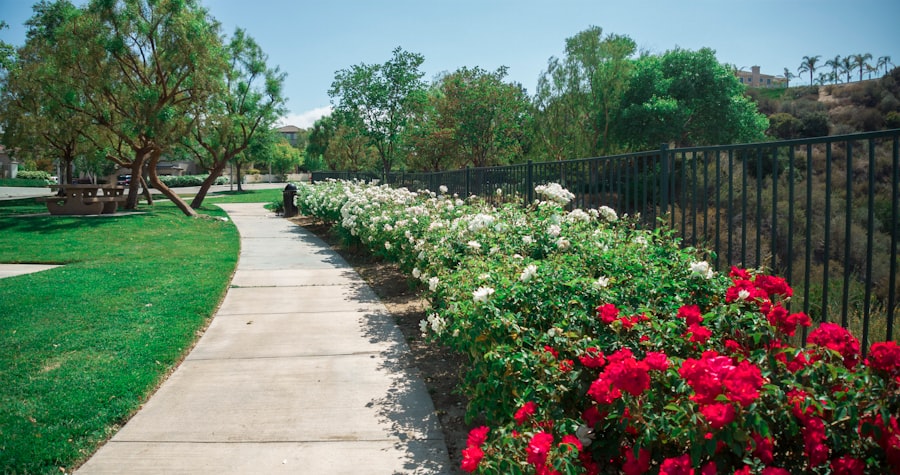
Fencing and netting are effective physical barriers that can be used to deter quails from entering your garden and causing damage to your plants. Fencing should be at least 2 feet high and buried several inches into the ground to prevent quails from burrowing underneath. Additionally, the fencing should have small openings to prevent quails from squeezing through. Netting can also be used to cover individual plants or entire garden beds to protect them from quail damage. When using netting, it’s important to ensure that it is securely fastened and does not provide any gaps for quails to enter. By utilizing fencing and netting, you can effectively limit the access of quails to your garden and protect your plants from their foraging behavior.
In addition to traditional fencing and netting, electric fencing can also be an effective deterrent for quails. Electric fencing delivers a mild shock when touched by birds, creating a negative association with the area and deterring them from returning. It’s important to install electric fencing properly and maintain it regularly to ensure its effectiveness in deterring quails. By utilizing electric fencing in combination with traditional fencing and netting, you can create a comprehensive barrier that effectively protects your garden from quail damage.
Maintaining a Tidy Garden
Maintaining a tidy garden is essential in deterring quails from foraging in your yard and causing damage to your plants. Quails are attracted to areas with dense vegetation where they can find cover and nesting sites. By keeping your garden well-maintained and free of clutter, you can create an environment that is less appealing to quails. This may include regular weeding, pruning overgrown vegetation, and removing debris such as fallen leaves and branches. Additionally, keeping bird feeders clean and free of spilled seeds can also help minimize the attraction of quails to your yard.
In addition to maintaining a tidy garden, it’s important to address any potential nesting sites that may attract quails. This may include filling in holes or gaps in fences, removing brush piles or dense vegetation near buildings, and securing potential nesting sites such as sheds or outbuildings. By addressing potential nesting sites and maintaining a tidy garden, you can create an environment that is less hospitable to quails and reduce the likelihood of damage to your plants.
In conclusion, understanding quail behavior is essential in effectively managing their presence in your garden. By knowing their habits and preferences, you can implement strategies such as creating physical barriers, using repellents, implementing scare tactics, providing alternative food sources, utilizing fencing and netting, and maintaining a tidy garden to deter them from causing damage to your plants and landscaping. By taking proactive measures to make your garden less appealing to quails, you can effectively discourage them from frequenting your garden and protect your plants from their foraging behavior.
If you’re looking for ways to keep quail out of your garden, you might also be interested in learning about the Producers Pride Sentinel Chicken Coop. This innovative coop design not only provides a safe and comfortable space for your chickens but also helps to protect your garden from unwanted visitors. Check out the article here to discover how this coop can benefit both your chickens and your garden.
FAQs
What are some effective methods for keeping quail out of the garden?
Some effective methods for keeping quail out of the garden include using physical barriers such as fences or netting, using scare tactics such as motion-activated devices or reflective materials, and planting deterrent plants that quail dislike.
What type of fencing is best for keeping quail out of the garden?
A small-mesh wire fencing, such as chicken wire or hardware cloth, is best for keeping quail out of the garden. The fencing should be at least 3 feet tall and buried a few inches into the ground to prevent quail from digging underneath.
What are some plants that can deter quail from entering the garden?
Plants that have strong scents or prickly textures, such as lavender, rosemary, or thorny bushes, can deter quail from entering the garden. Quail also tend to avoid plants with strong flavors, such as garlic or onions.
Are there any non-lethal scare tactics that can be used to keep quail out of the garden?
Yes, non-lethal scare tactics such as motion-activated sprinklers, reflective tape or balloons, and scarecrows can be effective in deterring quail from entering the garden. These tactics startle the quail and make them think the area is unsafe.
Is it possible to attract quail to a specific area away from the garden?
Yes, it is possible to attract quail to a specific area away from the garden by providing them with an alternative food and water source, such as a designated feeding station or bird bath. This can help redirect the quail’s attention away from the garden.
Meet Walter, the feathered-friend fanatic of Florida! Nestled in the sunshine state, Walter struts through life with his feathered companions, clucking his way to happiness. With a coop that’s fancier than a five-star hotel, he’s the Don Juan of the chicken world. When he’s not teaching his hens to do the cha-cha, you’ll find him in a heated debate with his prized rooster, Sir Clucks-a-Lot. Walter’s poultry passion is no yolk; he’s the sunny-side-up guy you never knew you needed in your flock of friends!

